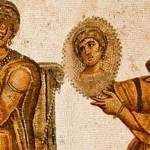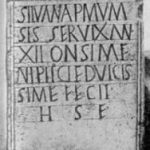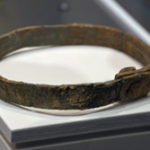Diverse Tales of Slaves, Sex, & Female Owners
- Erin Thomas Dailey
- 8 October 2025
- 0 Comment

By James R. Burns
This blog post contains some brief thoughts on how late antique literary sources show female slave owners exploiting the bodies of their slaves. It was prompted by the brilliant ‘Elite Women and Systems of Dependency in Late Antiquity’ workshop that I attended, with my project colleague Erin, at the Center for Dependency and Slavery Studies in Bonn. The workshop was organised by Aleksander Paradziński and Grace Stafford.
First, a few generalisations (which are probably debatable but, as this is a blog post, I’m taking a few liberties). It is well known among historians that both Roman and ‘barbarian’ law had a gendered double standard when dealing with unions and sexual relations between free people and slaves, generally being much more permissive for free men.[1] For example, both an edict of Emperor Constantine and the Merovingian Salic Law effectively threaten a free woman with death for entering into a union with her own slave.[2] Christian preachers like Caesarius of Arles (in early sixth-century Gaul) called out the sexual double standard [3], while emphasising the importance of female chastity or at least conjugal fidelity. On the whole, late antique legal culture tended to close down options available to female slaveholders for legitimising sexual relations with slaves.
But that’s not the end of the story. Several late antique narrative sources give us extended tales where women exploit the sexuality of their slaves. Crucially, many of these stories do not involve women having sex with or marrying their own slaves.
Perhaps the most infamous of these – at least among late antique scholars – is the tale of Euclia and Maximilla from the apocryphal Acts of the Apostle Andrew, a Greek text likely composed the second or third century.[4] In this tale, set in first-century Greece, a female slave owner named Maximilla wants – inspired by Andrew’s teachings – to be chaste without invoking the wrath and suspicion of her husband, the proconsul Aegeates. To accomplish this, she dresses up her slave Euclia in her clothes, and instructs her to sleep with her husband in her stead (pretending to be his wife). Euclia eventually asks for freedom and riches in return. The deception goes on undetected until Euclia’s fellow slaves rat her out to the pronconsul, who has her thrown to the dogs to die. As Jennifer Glancy, Kyle Harper, and others have observed, the original authors of the text apparently had no problem with a slave’s sexual honour and life being sacrificed for the sake of a free woman acting in accordance with her faith.[5]
This tale did not survive in the Latin version of the Acts, which it is now generally thought was revised by the sixth-century bishop-historian, Gregory of Tours.[6] Gregory did, however, preserve another story from the Acts, where a female slave owner also compromises the sexual honour of a slave, yet this time receives a violent comeuppance: the story of Trofima and Callisto. In this story, it is the concubine Trofima who is inspired to be chaste by Andrew’s teachings. She then converts her master, the proconsul Lesbius, to Andrew’s teachings on sex. Angered by Trofima’s own chastity, her spouse tells the wife of Lesbius, Callisto, that ‘Trofima has resumed her role as a prostitute again, a role she had been accustomed to play with my master, the proconsul. Now she is [having sex] with him again.’ Callisto replies, ‘That is the reason my husband left me, and for six months has not slept with me, because he lives his [female slave].’ She arranges for Trofima to be condemned to a brothel, presumably to degrade and humiliate her. Trofima is able to preserve her chastity thanks to her belief in God. Callisto, meanwhile, is beaten to death in the baths by a demon, a fate perhaps intended to ironically recall the vulnerability of prostitutes. Andrew the Apostle, acting mercifully, resurrects Callisto, who repents of her actions. This anecdote, then, gives us the image of a bad mistress, who is righteously (if temporarily) punished for exposing a pious female slave to sexual exploitation.
Another interesting tale featuring female slave owner comes from the seventh-century Chronicle of Fredegar, an anonymous Merovingian source.[7] Without children of her own and wanting an heir, a certain Eugenia directs two of her slaves, Lilia and Theodorus, to marry and sleep together. She also orders Lilia to tell her what she dreams after sex, believing this will give an insight into the future prospects of the child. Eugenia does this with the knowledge of her husband, the patrician Idacius, but it is she who takes the initiative. Lilia becomes pregnant by Theodorus, but, on the advice of the latter, lies about what she dreamed to Eugenia, probably to further increase the attractiveness of her child as an heir for her masters. Idacius and Eugenia free the slaves and adopt their son (the future Ostrogothic king Theoderic the Great) as their own. (Find out more from my previous blog post about this source!)
The tales of Maximilla, Callisto and Eugenia show that people in Late Antiquity envisioned a range of ways that female owners could exploit the sexuality of their slaves beyond having sex with them themselves: through sending enslaved women to sleep with their husbands; to condemning them to prostitution; and to arranging sexual relationships between their slaves.
On occasion, we do have stories where free women have sexual relations with their own slaves. The aforementioned Gregory of Tours gives a lengthy anecdote about how the Ostrogothic queen Amalasuntha ran off with her slave Traguila.[8] Traguila is killed by agents working for Amalasuntha’s mother. Amalsuntha poisons her mother in revenge. Like Callisto, Amalasuntha is later murdered in the baths.
There is a reason I have referred to these anecdotes as ‘tales’. None of them relate real events. The Acts of Andrew is the hagiographical equivalent of an ancient novel or romance. Theoderic the Great was not the son of two slaves. And Amalunstha was not killed for taking a slave as her lover. But, as I noted in my Bonn paper and as Julia Hilner also highlighted in the workshop discussion, our late antique authors – who tend to be male and ecclesiastical – seem to have relished the chance to imagine lengthy stories where free women exploited the sexuality of slaves. The paterfamilias may have been the archetypical household head, but our authors were alive to the possible power of female slaveholders, including in matters of sex. Indeed, the tales likely derived relevance from the ability of actual women to purchase and own slaves in Late Antiquity (see my earlier blog post, ‘The Wary Widow’s Slaves’).
In some of the tales, the women meet with violent fates and faced scorn from our authors: Amalsuntha for disgracing her own sexual honour; Callisto for compromising the sexual honour of her worthy female slave. These stories allowed their authors to construct models of female sexual virtue and household management through exemplars of bad behaviour. But we see no hostile judgements (at least explicitly) in the stories of Maximilla and Eugenia.
A further striking feature shared between most (not all) of these stories is that they allow for slaves to exercise agency. Euclia leverages her position to obtain rewards, and is depicted bragging about this to the other servile members of the household. And, in some of the other tales, slaves deceive or work against their dominae. Trofima resists the sexual degradation Callisto seeks to inflict upon her. And Lilia and Theodora lie about their dream in pursuit of opportunities for themselves and their child. Fanciful, literary tales allowed our authors to explore the capabilities of both free women and slaves to influence, make and break the Christian household. For that reason alone, our understanding of slaveholding practices in Late Antiquity would be impoverished without them.
Author’s note: I thank Grace and Aleksander for their invitation to the workshop, and the other participants for a fantastic discussion. I will discuss some of these sources in my thesis (on domestic slavery in sixth-century Gaul) and/or my contribution towards the volume that should hopefully arise out of the workshop.
Notes
[1] See Judith Evan-Grubbs, ‘“Marriage more shameful than adultery”: slave-mistress relationships, “mixed marriages”, and Late Roman law’, Phoenix, 47.2 (1993), 125–154. There are important differences in how laws deal with sexual unions depending on factors like whether the slave is freed; whether the union constitutes a legal marriage; and to whom the slave belongs to their owner or somebody else, etc., etc. Since this blog post is not primarily about the law on such unions, I skip over them here.
[2] Cod. Theod. 9.9; Pactus legis Salicae 98. To be more precise, the PLS says a free woman who marries her own slave can be killed with impugnity by her relatives.
[3] See Lisa Kaaren Bailey, ‘“These are not men”: sex and drink in the sermons of Caesarius of Arles’, Journal of Early Christian Studies, 15, no.1 (2007), 23–43.
[4] Ed. and trans. Dennis Ronald MacDonald, The Acts of Andrew and The Acts of Andrew and Matthias in the City of Cannibals (Atlanta: Scholars Press, 1990).
[5] Jennifer Glancy, Corporal knowledge: early Christian bodies (Oxford: Oxford University Press, 2010), pp. 67–68; Kyle Harper, From shame to sin: the Christian transformation of sexual morality in Late Antiquity (Cambridge, Mass.: Harvard University Press, 2013), 210–212.
[6] Gregory of Tours, MA, c. 23, ed. and trans. Randy Richardson [slightly modified].
[7] Chronicarum quae dicuntur Fredegarii, 2.57.
[8] Gregory of Tours, DLH 3.31.





